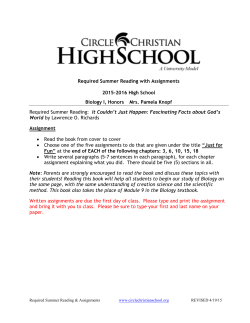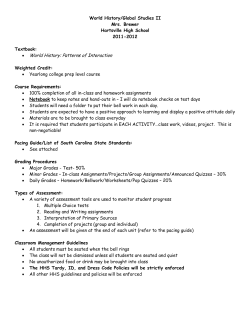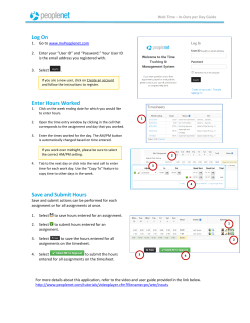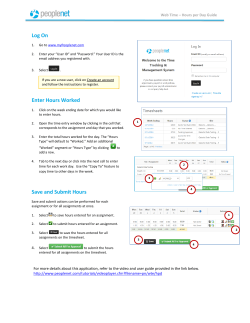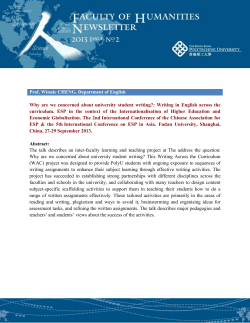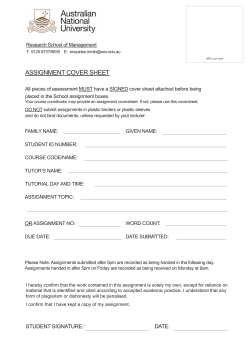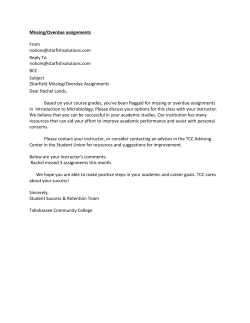
BUSINESS COMMUNICATION - College Of Business and Economics
BusCom 201 – Business Communication – Spring 2015 Sec. 006 – TuTh 9:00-10:15 a.m. – MBEB 1106 Instructor: Office: Office Hours: Patrick Delana MBEB 3110 Before and after class And by appointment Phone: Email: 426-3310 pdelana@boisestate.edu Course Objectives and Assessment Methods Welcome. The general objective of this class is to help you develop communication strategies and abilities that will enhance your college work and enable you to meet workplace communication expectations and needs. If you have great insights, but cannot effectively communicate them, are those insights of any value to you or anyone else? Students completing BusCom 201 should be able to demonstrate the ability to: 1. Appreciate the importance of effective business communication skills for career development and success. Learning strategies and assessment: Class discussion; Written assignments 2. Apply effective principles relevant to the content, organization, channel, and tone/style for the following types of business communication: bad news (negative) messages, persuasive messages, good news (positive) or routine messages, and employment application messages. Learning strategies and assessment: Class discussion; Written assignments 3. Use a reader-friendly approach to balance the needs of the audience with the desires of the sender to produce messages that are clear, complete, compelling, concise, and correct. Learning strategies and assessment: Class discussion; Written assignments 4. Find and properly incorporate secondary research using the APA style. Learning strategies and assessment: Written assignments 5. Develop and present an oral presentation for a targeted audience using effective delivery techniques and visual aids. Learning strategies and assessment: Class presentation assignment Course COBE Core Learning Goals Students in this course will learn or practice the following COBE Core Curriculum concepts, methods, and skills: 2.1. Communicate effectively: Write messages and documents that are clear, concise, and compelling 2.2. Communicate effectively: Give oral presentations that use effective content, organization, and delivery BusCom 201 – Sec. 006 – Boise State University – Spring 2015 – Delana Page 1 of 13 3. Solve problems, including unstructured problems, related to business and economics 4. Use effective teamwork and collaboration skills 5. Demonstrate appropriate principles of responsible business practices 5.1 Resolve issues related to Individual Responsibility (Business Ethics) 5.2 Resolve issues related to Corporate Social Responsibility 5.3 Resolve issues related to Leadership Responsibility (Corporate Governance) 5.4 Resolve issues related to Environmental Responsibility (Environmental Sustainability) 5.5 Resolve issues related to Cultural Responsibility (Diversity) Special Needs As we have in the past, BUSCOM instructors will make all appropriate and necessary accommodations to all students in adherence with the Americans with Disabilities Act, including provisions for additional time for testing, alternate document formats and types, approved transcriptionists in cases of hearing impairment, among other interventions/accommodations. If you have special needs (including those addressed by the Americans with Disabilities Act) and need assistance, please notify me as soon as possible. BUSCOM 201: Communication in the Discipline (CID) Boise State’s Foundational Studies Program provides undergraduates with a broad-based education that spans the entire university experience. BUSCOM 201 satisfies the three (3) credits of the Communicating in the Discipline requirement for business students. BUSCOM 201 supports the following University Learning Outcomes (ULO): ULO1: Write effectively in multiple contexts for a variety of audiences ULO 2: Communicate effectively as a speaker and listener BUSCOM 201 will help students improve their abilities to analyze business communication situations and develop appropriate communication strategies. After successful completion of this course, you will be able to: • Design, draft, and edit a variety of business message types (routine; bad-news; persuasive; employment-based). (ULO 1) • Use a reader-friendly approach to balance the needs of the audience with the desires and objectives of the writer. (ULO 1) • Develop and give an oral business presentation using effective visual aids. (ULO 2) BusCom 201 – Sec. 006 – Boise State University – Spring 2015 – Delana Page 2 of 13 Foundational Studies ULO Criteria and Notions of Exemplary Work ULO 1: Write effectively in multiple contexts for a variety of audiences ULO 2: Communicate effectively as a speaker and listener Course Learning Outcomes “By the end of this course, each student should be able to…” Design, Draft, Edit, and Assess a variety of business message types: goodnews/routine; bad-news; persuasive; employmentrelated Use a reader-friendly approach to balance the needs of the audience with the desires and objectives of the writer. Develop and present an oral presentation using effective visual aids. Assessment Method: Evidence of Student Learning Planned Teaching and Learning Activities/ Pedagogy Students will participate in instruction for each message type and will draft and edit four separate messages. Instructors, and possibly students in the class, will assess these assignments. The instructor and the students will (1) discuss the business communication situation and needs, (2) review sample messages prior to drafting, and (3) discuss students’ performance for each message type. The instructor usually will use rubrics for assessment in the instruction and assessment process. Students will participate in structured exercises and practice for reader-orientation. The instructor will assess reader-orientation, both in terms of rhetorical content and page format and layout, for all written assignments. Students will make at least one formal oral presentation in the course of the class. Students will participate in the instruction and review of effective oral business presentations strategies and techniques by discussion sample presentations, bestpractice checklists, and assessment rubrics. Statement of Shared Values Boise State University upholds the following values as the foundation for a civil and nurturing environment. Campus community members and all who are part of COBE are expected to adhere to the following values. Academic Excellence – engage in our own learning and participate fully in the academic community’s pursuit of knowledge. Caring – show concern for the welfare of others. Citizenship – uphold civic virtues and duties that prescribe how we ought to behave in a selfgoverning community by obeying laws and policies, volunteering in the community, and staying informed on issues. Fairness – expect equality, impartiality, openness and due process by demonstrating a balanced standard of justice without reference to individual bias. Respect – treat people with dignity regardless of who they are and what they believe. A respectful person is attentive, listens well, treats others with consideration and doesn’t resort to intimidation, coercion or violence to persuade. BusCom 201 – Sec. 006 – Boise State University – Spring 2015 – Delana Page 3 of 13 Responsibility – take charge of our choices and actions by showing accountability and not shifting blame or taking improper credit. We will pursue excellence with diligence, perseverance, and continued improvement. Trustworthiness – demonstrate honesty in our communication and conduct while managing ourselves with integrity and reliability. Course Materials Lehman & Dufrene, BCOM_6 (South-Western Cengage) Recommended COBE Writing Styles Guide (http://cobe.boisestate.edu/students/cobe-writing-styles-guide/) Course materials are also available on Blackboard See other resources listed on page 7 below. Course Structure & Organization This course is generally divided into four components: Part 1 Part 2 Part 3 Part 4 General Principles & Processes for Business Communication: The 4 Steps & The 3 Cs Common Business Message Types: Good-News, Bad-News, & Persuasive Messages Targeted Message Exercises: Ethics & Job Applications Business Case: Written & Oral Review the basic features that tend to distinguish business communication from other types of communication (e.g., academic & social) Review & practice three of the most common types of business messages Focus on the challenges of ethical communication and job application messages Review & practice the steps and components used to make compelling business cases to support decision making BusCom 201 – Sec. 006 – Boise State University – Spring 2015 – Delana Page 4 of 13 Course Components Grades in this class will be based upon the following: Assignments Genre Assignments #1 Instructor Message (CR/NC) #2 Editing Exercise #3 Good-News Message #4 Negative-News Message #5 Persuasive Message #6 Ethics Exercise #7 Application Letter & Resume Business Case Project Assignments #8 Business Case Proposal #9 Business Case #10 Conventional PowerPoint Slides 4-5 Minute Oral Presentation + #11 PowerPoint Course Assignments #12 Final Evaluation (CR/NC) #13 Final Assessments (CR/NC) (A) Editing & Assessment Workshops & #14 (B) Annotated Bibliography Assignments (CR/NC) Total Points % of Final Grade 10 50 50 50 50 20 50 2% 10% 10% 10% 10% 4% 10% 20 50 50 4% 10% 10% 50 10% 10 10 2% 2% 30 6% 500 100% Your Points Course Grade Scales Grades will be tabulated according to the following scales: A AB+ B BC+ C C- A = = = = = = = = 50 point assignments 50 points D = 30 points 47 points F = 25 points 44 points NS = 0 points 43 points 41 points 39 points *NS=Not submitted 38 points 36 points = 450-500 20 point assignments A = 20 points A- = 19 points B+ = 18 points B = 17 points B- = 16 points C = 15 points D = 13 points F = 10 points NS = 0 points Final Course Grade (500 points total) 435385B+ = C+ = D+ = 335-349 449 399 420370B = C = D = 320-334 F < 299 434 384 400350B- = C- = D- = 300-319 419 369 BusCom 201 – Sec. 006 – Boise State University – Spring 2015 – Delana Page 5 of 13 BusCom 201 – Sec. 006 – Boise State University – Spring 2015 – Delana Page 6 of 13 Evaluation Criteria Superior Work: A Good Work: B Acceptable Work: C Needs Work: D-F All assessment criteria met or exceeded. Document accomplishes its task effectively. No errors. The reader appreciates the communication. Your manager is impressed. Most assessment criteria are met. Document accomplishes its task, but lacks distinction. Possibly one or two minor errors. The reader completes the communication. Your manager is satisfied. Weak on some assessment criteria. Document basically accomplishes its task, though questions may arise. Errors may be noticed by the reader. Your manager accepts the work, but has concerns. Unacceptable Work: Very weak on assessment criteria. Reader is confused or doubtful about the message. Three or more errors. Your manager would ask you to revise the document and doubts your capability for the position. Please feel free to talk with me regarding any questions on grading and assessment. Grades of “Incomplete” are not normally given in this class. General Assignment Guidelines Assignments should be turned in on time. Late assignments will be accepted, but points will be deducted when work is submitted after the deadline. A late assignment cannot earn an A. Assignments will not be graded on the basis of how closely they replicate some textbook model, but rather on how well they accomplish the task contained in the assignment. There are many ways this can be accomplished. PROOFREADING Assignments will be read closely for spelling/typing, basic grammatical, and/or punctuation errors. Such mistakes seriously harm a message’s credibility. Gross (“red ink”) errors can lower an assignment’s point total by several points for each error. CODE NAMES Do not put your name on your final draft of an assignment that will be turned in for grading. Instead, put (1) a code name (a 6-character alpha-numeric string such as “C8S4MG”), (2) your section number, and (3) the assignment name in the upper right hand corner of the paper. You will sign in your code name on a separate sheet when you submit the assignment. You should use a different code name for each assignment. LATE ASSIGNMENTS If you turn an assignment in late or put your assignment in my mailbox, put your name on the back of the assignment. Points will be deducted if there is no name. All late assignments must be turned in by the last day of class. Assignments will not be accepted after the last day of class. E-MAIL ASSIGNMENT SUBMISSION If you submit an assignment via e-mail: 1. Put your name and BusCom section number in the e-mail subject line. 2. Do not put your name on the assignment. Use a code name, section number, and assignment name. 3. Submit the assignment as a MS Word/PowerPoint attachment. 4. Watch for my reply indicating that I received the assignment. If you do not receive a reply from me to your e-mail, you should not assume I received the assignment. ASSIGNMENT FORMATS BusCom 201 – Sec. 006 – Boise State University – Spring 2015 – Delana Page 7 of 13 General assignment format requirements: Fonts: Use conventional fonts (e.g., Times New Roman for serif, Arial for sans serif) Line Spacing: Single space the text with a blank line between paragraphs with no paragraph indentation. Margins: About 1 inch There is not one uniform format for business communication. For assignments in this class, the following general guidelines are provided: Letters Use the Block letter format. Provide “letterhead” information (e.g., company name and contact information) at the top of the message, date, and inside (recipient’s) address. Salutation: Use last name or first name; not both. Use first name only if you would be comfortable addressing the reader by his or her first name when making a telephone call. When in doubt, use last name with Mr. or Ms. Use a colon with last name. Commas are acceptable with first name, informal salutations. Memos/E-mails Use any conventional format that includes, at the top, “To,” “From,” “Date,” and “Subject” lines. Self-Assessment Policy: The “Bump” Option For each graded assignment you will complete a self-assessment of that assignment. If you can show that your self-assessment effectively anticipates the areas that need improvement in the assignment, you can improve (“bump”) the assignment grade by 1/3 grade (e.g., from a C+ to B- or from a B to a B+). Rewrite Policy You will have the option to rewrite one of your graded, assignments: the Editing Exercise, the Routine Message, the Negative-news Message, the Persuasive Message, the Ethics Exercise (written), the Application Letter, the Report Proposal, or the Executive Summary. To improve the grade for the assignment, the rewrite must show substantial improvement over the graded version. Mere cosmetic alterations in response to readers' comments will not necessarily result in a higher grade. If the rewrite contains any (red ink) errors, no improvement to the grade will result. And indulgence cards (see below) may not be used for rewrites. The rewrite must be accompanied by the original graded version along with all of the readers' comments. If the graded version and comments are not included, the rewrite will not be accepted. The due date for the rewrite is indicated on the class schedule. Indulgence Cards To err is human…. If you are the first in the class to notice an error in any of the course materials, you can obtain a “BusCom Indulgence Card” which can be used to “erase” one ‘red ink’ error from any of your one-page assignments. Indulgence cards and assignments should be submitted when the rewrite is due. Course Presumptions Participants in the class are presumed to have Completed ENG 101 and ENG 102 and are, thereby, familiar with the basic principles of English grammar, punctuation, and style. Take appropriate steps if you need additional review on these issues. BusCom 201 – Sec. 006 – Boise State University – Spring 2015 – Delana Page 8 of 13 Written documented research papers using a style guide such as MLA or APA. Documentation will be briefly discussed in class, but you should be familiar with the basic principles and objectives. Mastered word processing and graphics (e.g., PowerPoint) software applications. Developed a willingness and ability to seek clarification if they have any questions regarding the assignments. Workshop Attendance Regular attendance and contributions are expected at all classes and workshops. Admission to editing workshops requires completion of assignment drafts. The only “excuses” accepted in this class for absences are (1) university-sanctioned activities and (2) official civic duties such as jury duty. Class Etiquette Please silence your cell phone during class. If you must take and/or reply to a call, please quietly and quickly leave the room to do so. Please do not exchange text messages during the class. If you are late, please enter without disrupting the class. Academic Honesty Each student is required to do his or her own work on graded assignments, and to abide by the policies set forth in the Boise State University Student Code of Conduct. Violations may result in penalties up to and including dismissal from the University. More detail on the Student Code of Conduct can be found at: http://www2.boisestate.edu/studentconduct/studentinformation.htm How to Get an A in BUSCOM 201 Here are some tips from former students who obtained an A in this class: Be sure to attend class every day, come prepared with your assignments ready to workshop, and get involved in the workshops. Use fellow classmates to your advantage both during class time and outside of class. Meeting outside of class in small groups to further edit and revise each other’s work will improve your work and your study partners’ work. My advice to future students would be to attend class. Attendance everyday should be mandatory...Also, the examples shown in class are crucial to understanding how to write your own assignment. Another piece of advice would be to do everything the professor recommends doing. Listen to his advice, work on the half sheets, and bring drafts on time. I think that putting a good amount of effort into the drafts is worthwhile because it is the only chance for others to help you improve. Use the comments on the professor to improve your next assignment. I would tell future students that the class is a lot of work and you need to allow more time to complete assignments than you might think you need. My advice to future students is to read all directions thoroughly. The first couple of assignments provided useful information that you had to go out and find. I learned after crashing and burning to go to the websites listed and gather as much information as you can. This well help build a credible compelling case for your assignments. BusCom 201 – Sec. 006 – Boise State University – Spring 2015 – Delana Page 9 of 13 When it comes to editing your work, you are your own worst enemy. Produce a complete and final draft of the assignment before having the peer review group read it. They will find the errors that your eyes skip over. If you wait to write the final draft until the due date, you will miss out on this critical step and it will reflect upon your grade. Every English class teaches you how to write. Business Communications teaches you how to successfully get your message to the reader. Use headers, simple audience friendly words, concise paragraphs and white space so the reader doesn't have to work to understand what you're trying to say. You will soon find out that the next 16 weeks in Patrick Delana's BusCom 201 class are not going to be easy. Here are some tips to get you through the semester: 1. Utilize the 3C's 2. Make the Case...get to the point! 3. Always consider your reader 4. If you need help or have a question, ASK! Or make an appointment to meet with Pat. Hint: Doing this shows the professor you care and that you take the class seriously. 5. Don't procrastinate 6. Have several people outside of class look over your papers to give you feedback. 7. There is no 'one way' to do an assignment, so don't be afraid to be a little creative. I promise if you put forth the time and effort an 'A' in Patrick Delana's class is possible. The advice I have to offer you to receive an A in BUSCOM 201 is to attend and participate in all classes, commit to doing your very best on each assignment, and open yourself up to constructive criticism in an attempt to improve your communication. As a returning student who works in a business environment, it was easy to feel as though my style of communication was effective. However, I learned how to better clarify and achieve the objectives of my messages through feedback I received during peer editing sessions and the comments presented by Pat. If you are of the mindset that you have previously acquired the skills that will be taught and practiced in BusCom 201, BusCom 201 will waste your time. To you, the openminded student, BusCom 201 provides an opportunity to identify communication strengths and weaknesses. Your success in class will be determined by your willingness to improve on your weaknesses. Personalize each assignment as a means of making yourself a better communicator and put in the time required for you to be satisfied. Resources There are many good resources for Business Communication. Here are just a few that might help: TEXTBOOKS Thill, J.V., & Bovée, C.L. Excellence in business communication (Any edition). Prentice Hall. Guffey, M.E. Essentials of business communication (Any edition). ThompsonSouthwestern. Locker, K.O. Business and administrative communication (Any edition). McGraw-Hill. NON-TEXTBOOKS Blake, G. & Bly, R.W. (1991). The elements of business writing. New York: Longman. Munter, M. (2009). Guide to managerial communication: Effective business writing and speaking (8th ed). Upper Saddle River, NJ: Prentice Hall. Fugere, B., Hardaway, C., & Warshawsky, J. (2005). Why business people speak like idiots. New York: Free Press. BusCom 201 – Sec. 006 – Boise State University – Spring 2015 – Delana Page 10 of 13 Journals: Business Communication Quarterly Journal of Business Communication FOR PRESENTATIONS Weissman, J. (2006). Presenting to win. New Jersey: FT Press. Gallo, C. (2010). The presentation secrets of Steve Jobs. New York: McGraw Hill. Weissman, J. (2009). The power presenter. Hoboken, NJ: John Wiley & Sons. Reynolds, G. (2008). Presentation zen. Berkeley, CA: New Riders. Duarte, N. Slide:ology: The art and science of creating great presentations. Sebastopol, CA: O’Reilly Course Schedule PART 1: General Principles and Processes for Business Communication: 4 Steps & 3 Cs Week 1 Tu 13-Jan Course Introduction In-class: Assignments, Assessments, & Resources Th 15-Jan Due: FINAL #1 Instructor Message (No code name; 2 copies): Proofreading Workshop In-class: What is Communication & Business Communication? BusCom 201 – Sec. 006 – Boise State University – Spring 2015 – Delana Page 11 of 13 Week 2 Tu 20-Jan Due: Draft #2 Editing Assignment (4 copies) Editing Workshop In-class: Editing vs. Proofreading Th 22-Jan Due: FINAL #2 Editing Assignment (Code Name; 2 copies) Assessment Workshop In-class: Communication Process & Strategy Week 3 Tu 27-Jan In-class: Document Design & Reader Orientation Exercises Due: Bibliography #14_1 (No code name; 1 copy) PART 2: Common Business Message Types: Good-News, Bad-News, & Persuasive Messages Th 29-Jan In-class: Style Exercises & Intercultural Communication Workshop: Prep #3 Week 4 Tu Th Week 3-Feb Due: Draft #3: Good News (4 copies) Editing Workshop 5-Feb Due: FINAL #3 Good News (Code Name; 2 copies) Assessment Workshop Workshop: Prep #4 5 Tu 10-Feb Due: Draft #4: Bad News (4 copies) Editing Workshop Th 12-Feb Due: Draft #4: Bad News (4 copies) Editing Workshop Week 6 Tu 17-Feb Due: FINAL #4 Bad News (Code Name; 2 copies) Assessment Workshop Workshop: Prep #5 Th 19-Feb Due: Draft #5: Persuasive Message (4 copies) Editing Workshop Due: Bibliography #14_2 (No code name; 1 copy) Week 7 Tu 24-Feb Due: Draft #5: Persuasive Message (4 copies) Editing Workshop Workshop: Prep #6 Part 3: Targeted Message Exercises: Ethics & Job Applications Th 26-Feb Due: FINAL #5 Persuasive (Code Name; 2 copies) Assessment Workshop DUE: Draft #6 Written Exercise (1 copy only) In-class workshop: Practice #6 Week 8 Tu Th Week 3-Mar Due: FINAL #6 Ethics Role-play Exercise Workshop: Prep #7 5-Mar Due: FINAL #6 Ethics Written Exercise Due: Draft #7: Resume (4 copies) Editing Workshop 9 Tu 10-Mar Due: Draft #7: Application Letter (4 copies) Editing Workshop Th 12-Mar Due: FINAL #7 App. Letter & Resume (Code Name; 2 copies) Assessment Workshop Workshop: Prep #8--#11 BusCom 201 – Sec. 006 – Boise State University – Spring 2015 – Delana Page 12 of 13 Part 4: Business Case: Written & Oral Week 10 Tu 17-Mar Due: Draft #8: Case Proposal (4 copies) Editing Workshop Th 19-Mar Due: FINAL #8 Case Proposal (Code Name; 2 copies) Assessment Workshop Workshop: Prep #9 Week 11 Tu 24-Mar SPRING BREAK Th 26-Mar SPRING BREAK Week 12 Tu 31-Mar In-class: Building Credibility & Incorporating Sources Th Week 13 Tu Th 2-Apr In-class: Problem-solving, Language of Business & Case Formats 7-Apr Due: Draft #9: Business Case (4 copies) Editing Workshop 9-Apr Due: FINAL #9 Business Case Due (Code Name; 2 copies) Assessment Workshop Workshop: Prep #10 & #11 In-class: Schedule Oral Presentations Week 14 Tu 14-Apr Prep #11 Oral Reports/Listening Exercises Due: Optional Rewrite (+ original graded version) Th 16-Apr Prep #11 Oral Reports/Listening Exercises Due: Draft #10: Conventional PowerPoint (4 coipies) Editing Workshop Week 15 Tu 21-Apr Due: Final #10 Conventional PowerPoint (No code name; 1 copy) Due: #11 Oral Reports/Listening Exercises Th 23-Apr Due: #11 Oral Reports/Listening Exercises Week 16 Tu 28-Apr Due: #11 Oral Reports/Listening Exercises Th 30-Apr Due: #11 Oral Reports/Listening Exercises Due: All Late/Missing Assignments FINAL EXAM PERIOD: 006 Due: Final #12 Final Evaluation Due (No Code Name; 1 copy) In-class Assignment #13: In-class Assessments Tuesday, May 5, 2015 10 a.m.--noon BusCom 201 – Sec. 006 – Boise State University – Spring 2015 – Delana Page 13 of 13
© Copyright 2025
